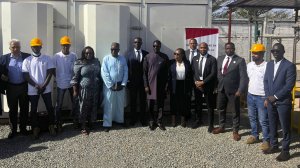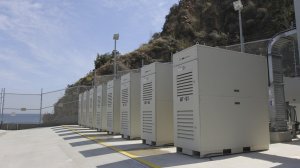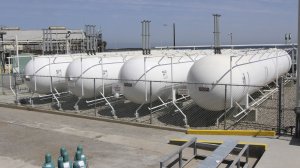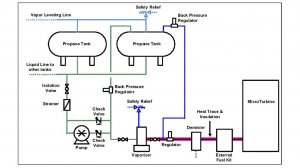Fuel for Thought: Liquified Petroleum Gas
By: Gorgui Ndoye, Senior Business Development Director
The past several years have shown that a range of fuel options for power generation is an important hedge against instability. Fuel flexibility is a hallmark of Capstone microturbines, which can run off a variety of sources, from natural gas and propane to methane, hydrogen, and more.
Today we’re spotlighting liquefied petroleum gas (LPG), a widely available fuel that is an excellent alternative to diesel and other expensive, “dirty” fuels. This primer explains the types of commercially available LPG and how they can integrate into Capstone microturbine systems.
What is LPG?
LPG is a mixture of propane (C3), butane (C4), and small quantities of various other hydrocarbons, such as propylene and butylene.
LPG is transferred and stored as a pressurized liquid; however, its boiling point is such that it evaporates easily under ambient temperature and pressure. The molecular composition of LPG determines the dew point, heating value, density, and many other properties, as well as the percentage of contaminants. These values determine whether a fuel can be used in an engine or turbine. For this reason, it is important to know the composition of the LPG before designing the fuel delivery system. Because the LPG composition can vary significantly between fuel types, Capstone enhanced the fuel capabilities of the C200 and C1000 series microturbines to use a variety of LPG.
The four most common commercially available types of LPG are Special Duty Propane (HD-5), Commercial Propane (HD-10), Propane-Butane Mixtures (PB Mix), and Commercial Butane. LPG can also be mixed with conditioned air to make an LPG/Air Mixture. The addition of air may alter the overall fuel properties to a more desirable level for operation. Capstone’s microturbines can run using HD-5, PB Mix, or LPG/Air Mixtures.
When comparing LPG to Natural Gas (NG), it’s important to note the heating value difference. NG has an average heating value of 1,000 Btu/scf. SD-5 is roughly 2,500 Btu/scf, and Commercial Butane is over 3,000 Btu/scf. Therefore, the heating value of LPG is 2.5 to 3 times greater than NG. So, LPG requires much lower volumetric flow rate to achieve the same engine output. LPG is also stored as a liquid, which compresses the fuel volume 250:1—without costly cryogenics required by LNG. These factors offer a small footprint for LPG compared to NG’s need for pipelines and large infrastructure, and LPG can be transported easily and stored in tanks, making it a good diesel replacement.
Using LPG in Microturbines
Special Duty Propane
Special Duty, or HD-5, Propane is defined as greater than 90% propane and less than 5% propylene. This grade is ideal for all types of engines and turbines due to the burn’s cleanliness and the low level of contaminants relative to diesel.
All Capstone microturbines have a version that can operate using HD-5 Propane.
Propane-Butane Mixtures
Propane-Butane Mixtures, or PB Mix, have no standard specification for their compositions and can be a problem for gaseous fuel operation due to the low dew point of butane. The higher the concentration of butane, the lower the dew point falls, and the more heat tracing and insulation needed with the fuel delivery system. This causes a higher risk of fuel condensation, which may lead to engine problems. The LPG-capable C200 and C1000 series microturbines were designed with a versatile fuel system. This includes internal heat tracing and fuel line insulation, which reduce the risk of condensing vapor from heavier fuels. The goal of the heat tracing and insulation is to maintain the supplied inlet fuel temperature without needing to increase the fuel temperature or vaporize condensed liquids.
The LPG-capable C200 and C1000 microturbines are approved to operate using a Propane-Butane Mixture of up to 40% butane. This does not mean that PB Mixtures containing greater than 40% butane are disqualified. Capstone applies the same limitations towards propylene, limited to less than 5%, as well as all other contaminants listed in the Special Duty Propane specification.
LPG/Air Mixtures
Certain LPG types that are not suitable for microturbines may be approved when mixed with air. Alternatively, the mixture may attempt to match the properties of a more standard fuel, such as NG. LPG/Air mixtures are not standard and may require complex fuel delivery systems. The approval of these fuel types depends on review of the fuel properties and composition. Detailed analysis would be needed to determine feasibility for use in microturbines.
Real-World Application
In March 2023, a 600 kW, C600S, LPG-fueled system was commissioned at a remote food processing facility in Bamako, Mali. Like many land-locked countries, Mali relies on expensive, “dirty” fuels like diesel and heavy fuel oil, so this project was important in demonstrating the benefits of a system whose fuel is less expensive and more environmental.
The new system also improves reliability, which addresses issues of load shedding and blackouts the facility had previously experienced. Because the microturbines also require very little maintenance compared to other technologies like diesel generators, power availability and cost savings were also improved.
"The Mali project is a model for other customers and power companies, showing the benefits of LPG as an alternative fuel," said Gorgui Ndoye, business development director for Capstone Green Energy. "There is tremendous opportunity to use LPG in many regions around the globe, but it can play an especially important role in Africa as part of the continent’s energy transition."
Better for Business and the Environment
It’s difficult to underestimate the positive impact that added reliability and cost savings have on the bottom line. Often, the combination of LPG and microturbines offers significant upside—including cleaner fuel and lower emissions. What’s more, once a customer decides to go with Capstone, we can fast-track and deploy nearly anywhere within three months of order.
The world’s energy landscape won’t become more predictable. Smart power security decisions made today will set businesses up to confidently navigate the future. An LPG-fueled microturbine system could be the answer.
Contact:
Comments
Press Office
Announcements
What's On
Subscribe to improve your user experience...
Option 1 (equivalent of R125 a month):
Receive a weekly copy of Creamer Media's Engineering News & Mining Weekly magazine
(print copy for those in South Africa and e-magazine for those outside of South Africa)
Receive daily email newsletters
Access to full search results
Access archive of magazine back copies
Access to Projects in Progress
Access to ONE Research Report of your choice in PDF format
Option 2 (equivalent of R375 a month):
All benefits from Option 1
PLUS
Access to Creamer Media's Research Channel Africa for ALL Research Reports, in PDF format, on various industrial and mining sectors
including Electricity; Water; Energy Transition; Hydrogen; Roads, Rail and Ports; Coal; Gold; Platinum; Battery Metals; etc.
Already a subscriber?
Forgotten your password?
Receive weekly copy of Creamer Media's Engineering News & Mining Weekly magazine (print copy for those in South Africa and e-magazine for those outside of South Africa)
➕
Recieve daily email newsletters
➕
Access to full search results
➕
Access archive of magazine back copies
➕
Access to Projects in Progress
➕
Access to ONE Research Report of your choice in PDF format
RESEARCH CHANNEL AFRICA
R4500 (equivalent of R375 a month)
SUBSCRIBEAll benefits from Option 1
➕
Access to Creamer Media's Research Channel Africa for ALL Research Reports on various industrial and mining sectors, in PDF format, including on:
Electricity
➕
Water
➕
Energy Transition
➕
Hydrogen
➕
Roads, Rail and Ports
➕
Coal
➕
Gold
➕
Platinum
➕
Battery Metals
➕
etc.
Receive all benefits from Option 1 or Option 2 delivered to numerous people at your company
➕
Multiple User names and Passwords for simultaneous log-ins
➕
Intranet integration access to all in your organisation


























